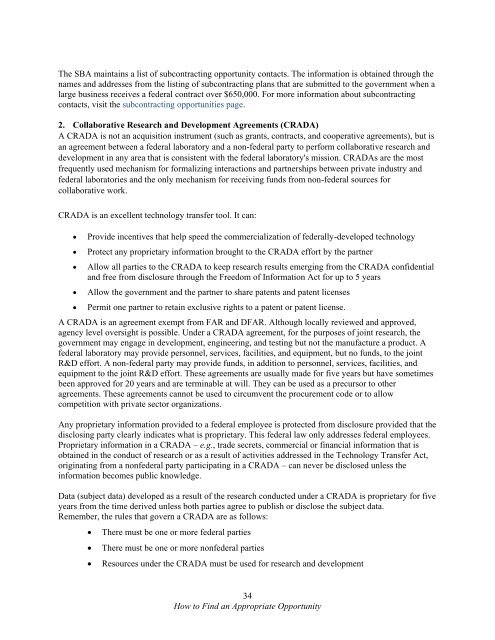Maryland’s
yeHP303GhlD
yeHP303GhlD
Create successful ePaper yourself
Turn your PDF publications into a flip-book with our unique Google optimized e-Paper software.
The SBA maintains a list of subcontracting opportunity contacts. The information is obtained through the<br />
names and addresses from the listing of subcontracting plans that are submitted to the government when a<br />
large business receives a federal contract over $650,000. For more information about subcontracting<br />
contacts, visit the subcontracting opportunities page.<br />
2. Collaborative Research and Development Agreements (CRADA)<br />
A CRADA is not an acquisition instrument (such as grants, contracts, and cooperative agreements), but is<br />
an agreement between a federal laboratory and a non-federal party to perform collaborative research and<br />
development in any area that is consistent with the federal laboratory's mission. CRADAs are the most<br />
frequently used mechanism for formalizing interactions and partnerships between private industry and<br />
federal laboratories and the only mechanism for receiving funds from non-federal sources for<br />
collaborative work.<br />
CRADA is an excellent technology transfer tool. It can:<br />
<br />
<br />
<br />
<br />
<br />
Provide incentives that help speed the commercialization of federally-developed technology<br />
Protect any proprietary information brought to the CRADA effort by the partner<br />
Allow all parties to the CRADA to keep research results emerging from the CRADA confidential<br />
and free from disclosure through the Freedom of Information Act for up to 5 years<br />
Allow the government and the partner to share patents and patent licenses<br />
Permit one partner to retain exclusive rights to a patent or patent license.<br />
A CRADA is an agreement exempt from FAR and DFAR. Although locally reviewed and approved,<br />
agency level oversight is possible. Under a CRADA agreement, for the purposes of joint research, the<br />
government may engage in development, engineering, and testing but not the manufacture a product. A<br />
federal laboratory may provide personnel, services, facilities, and equipment, but no funds, to the joint<br />
R&D effort. A non-federal party may provide funds, in addition to personnel, services, facilities, and<br />
equipment to the joint R&D effort. These agreements are usually made for five years but have sometimes<br />
been approved for 20 years and are terminable at will. They can be used as a precursor to other<br />
agreements. These agreements cannot be used to circumvent the procurement code or to allow<br />
competition with private sector organizations.<br />
Any proprietary information provided to a federal employee is protected from disclosure provided that the<br />
disclosing party clearly indicates what is proprietary. This federal law only addresses federal employees.<br />
Proprietary information in a CRADA – e.g., trade secrets, commercial or financial information that is<br />
obtained in the conduct of research or as a result of activities addressed in the Technology Transfer Act,<br />
originating from a nonfederal party participating in a CRADA – can never be disclosed unless the<br />
information becomes public knowledge.<br />
Data (subject data) developed as a result of the research conducted under a CRADA is proprietary for five<br />
years from the time derived unless both parties agree to publish or disclose the subject data.<br />
Remember, the rules that govern a CRADA are as follows:<br />
<br />
<br />
<br />
There must be one or more federal parties<br />
There must be one or more nonfederal parties<br />
Resources under the CRADA must be used for research and development<br />
34<br />
How to Find an Appropriate Opportunity


